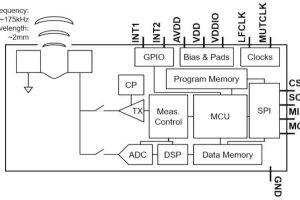
No permanent magnet, external or internal, is needed, and external magnetic fields are rejected. MLX92442 only requires a nearby electrically conductive object for triggering.
It comes in either a through-hole single in-line package (flattened TO-92) or a surface-mount SO-8, and is activated by objects within ~1mm of its front surface so long as they are at least 0.1mm thick and at least 2.32 x 10[superscript6]S/m conductive.
The through-hole version can be supplied with an integrated decoupling capacitor, otherwise one is required externally.
MLX92442 has only three connections: Two for power – anywhere from 3.5V to 18V – and the other is the output.
Operation is ‘three-wire’, with the output acting as an open drain, or ‘two-wire’, where current through the devices power rail is sensed elsewhere as the voltage drop across a 100Ω resistor.
When operated as a two-wire sensor, the IC built-in self-diagnostics and a dedicated safe mode can be used – the company intends it to be rated as an ISO26262 ASIL A ‘safety element out of context’ (SEooC).
In two-wire mode, it has three separate valid current ranges indicated: ‘triggered’, ‘not triggered’ and ‘safe-mode’. All other through-currents indicate a fault. Regarding safe mode, the company told Electronics Weekly: “This current indicates the device is in safe diagnostics mode. It enters if an error is detected from those described in the datasheet and our safety manual.”
“For safety-critical applications requiring heterogeneous redundancy, the inductive technology provides a highly reliable option with minimal design requirements that can operate next to the Hall effect and mechanical solutions,” according to the company.
Protections include reverse-polarity (two-wire mode), under-voltage lock-out and over-temperature (normal operation is across -40°C to 150°C).
To trigger the sensor, the conductive target can sweep past the face of the IC, or approach it from the nominal front.

Various patterns of holes through target sweeping in various directions, can be used to implement different behaviours – the data sheet, despite being preliminary, has chapter and verse on this.
One motion that will not trigger the IC is approaching the whole front at once, so it cannot be used to detect a wide conductive surface arriving in face-on.
It only switches ‘on’ when the conductive target covers just over half of the sensitive face. It is ‘off’ when the whole face is covered and when none of the face is covered.
Trigger distance varies but, as a very rough guide, sub-mm precision control of the gap between object and IC appears to be necessary, even if the swept motion can be much longer.
MLX92442 is also end-of-production-line programmable “It has EEPROM inside so a lot is programmable, ” Melexis told Electronics Weekly. “Today we recommend using it as-is for optimal air gap performance as a switch. On request, we can guide adjusting the: thresholds, compensation, inverted/direct behavior, low current level range, 3 or 2-wire mode of operation, switch or latch, and other settings to enable exploration of the customer’s application.”
Applications are foreseen detecting the closure of: vehicle charging power covers, passenger doors, rear hatches and seat belts, then as rotational speed sensors and as a replacement for mechanical contacts inside switches.
The device is sampling now. Find the MLX92442 web page here, the preliminary data sheet here (will initiate download), and there is a little about an evaluation kit here.
 Electronics Weekly Electronics Design & Components Tech News
Electronics Weekly Electronics Design & Components Tech News



